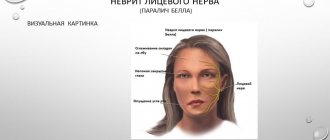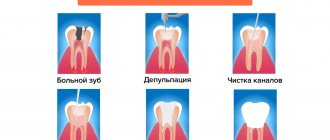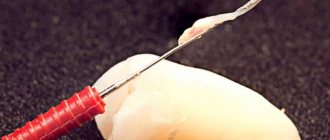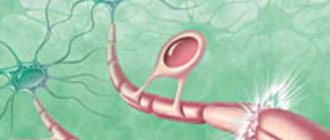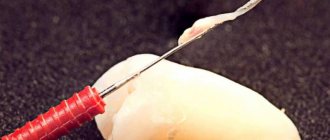Trigeminal and facial neuralgia
Neuralgia is a disease in which damage or compression of the trigeminal nerve and/or its branches occurs. This causes a sharp piercing pain that occurs suddenly and brings physical and psychological discomfort to the patient. Despite the fact that the term “neuralgia” can be literally translated as “nerve pain,” the matter is not limited to pain. Trigeminal and facial neuralgia are radically different in symptoms. The facial nerve contains mostly motor fibers, so neuralgia leads to dysfunction of the facial muscles (the degree depends on the severity of the disease), and can also cause lacrimation, dry eyes and partial loss of taste. Pain in facial neuralgia is usually concentrated in the area of the parotid gland (the patient complains that the pain radiates to the ear), but there may be no pain at all. It is because of the lack of pain that some experts use the term “neuropathy” when talking about damage to the facial nerve. With the trigeminal nerve it’s exactly the opposite, since it contains many sensory fibers.
Diagnostics
As a rule, the diagnosis is made based on the patient's complaints and examination data. Almost all patients with trigeminal neuralgia undergo magnetic resonance imaging of the brain at some stage to rule out a tumor or multiple sclerosis. In addition to computer and magnetic resonance therapy, radiography of the paranasal sinuses is used to identify chronic inflammatory and other pathological processes; OPTG (orthopantomogram) to assess the width of the bone canals.
The patient requires consultation with several specialists: an ENT doctor, a dentist, a neurologist. A preliminary diagnosis can be made by a neurologist based on the patient’s complaints, studying the history of his disease and an objective examination of the face with an assessment of symmetry at rest and when trying to smile.
Over time, symptoms of inflammation of the trigeminal nerve can give rise to neuropathic complications and lead to the development of secondary pain syndrome. In the chronic form of the disease, the auditory and facial nerves are irritated. Without treatment, trigeminal neuralgia can lead to more serious complications, such as dystrophy of the masticatory muscles; decreased sensitivity of the affected area; synkinesis (cooperative movements in which one nerve controls many muscles); contracture and spontaneous contraction of the facial muscles; chronic lacrimation.
Symptoms of neuralgia
- Facial pain (prosopalgia). A characteristic sign of neuralgia. Sharp and sudden, reminiscent of an electric shock. Usually lasts from 5 to 15 seconds, is paroxysmal in nature and can occur at any time. During periods of remission, the number of attacks decreases. Most often, pain occurs in the area of the cheekbones and lower jaw (both right and left), and can be localized in almost all areas of the face.
- Impaired sensitivity. A severe form of neuralgia can lead to partial or complete loss of sensitivity of the skin.
- Nervous tic of the eyelid (nystagmus), spasms and twitching of facial muscles.
- Loss of coordination and motor skills are rarer manifestations of severe forms of the disease.
- Headaches, fever, chills and weakness are syndromes caused by viruses and infections.
Treatment of sciatic neuralgia at home
Inflammation of the sciatic nerve, or sciatica. With this type of inflammation, pain occurs in the lower back, back of the thigh or lower leg. Discomfort increases during movement, especially under load. When a person is in a calm state, the pain syndrome decreases or disappears altogether. The cause of the disease, which affects the largest nerve in the human body, is arthritis or pinched nerve roots. An attack of neuralgia can begin unexpectedly, for example, due to an unsuccessful turn of the body, as well as from hypothermia.
A decoction prepared from viburnum flowers, calendula inflorescences, thyme, and horsetail will help relieve the acute phase of inflammation. These plants are taken in equal quantities. After mixing all the ingredients, pour 500 ml of hot water, boil over low heat for 5 minutes, cool and filter. Take 100 g of decoction orally 3 times a day.
Externally, to relieve suffering, the same means are used as in the treatment of intercostal neuralgia with herbs. A decoction of hot chili peppers is especially effective. An extract prepared from birch buds is also used for rubbing. The kidneys are infused for 7 days, first filled with a glass of vodka. The finished product does not even need to be filtered. Rub it into the sore spot before going to bed.
Causes
Unlike neuritis, neuralgia is not an inflammatory disease. Fever, fever, swelling and other symptoms of the inflammatory process are not associated with this disease. However, if the trigeminal nerve is damaged due to neuritis, pain sensations that fit the description of neuralgia may well occur. To avoid confusion and differentiate the two pathologies, it is necessary to consider their etiology.
The cause of neuritis (like any other inflammatory disease) is viruses and infections that cause gradual destruction of the membrane and nerve trunk, and classical neuralgia in the vast majority of cases occurs due to mechanical effects on the nerve. Today, experts identify dozens of factors that provoke the development of the disease.
Main causes of neuralgia
- Head injuries leading to changes in the cranial structure and displacement of bones.
- Benign and malignant tumors that, as they grow, compress the trigeminal nerve.
- Various bite pathologies and other dental anomalies.
- Pathologies of the structure and diseases of blood vessels located in close proximity to the nerve (atherosclerosis, aneurysm, vasodilatation, etc.).
- Sinusitis and otitis in chronic form.
- Trigeminal neuralgia after tooth extraction. Occurs during a traumatic or incorrectly performed extraction procedure.
- Damage as a result of infection resulting from a number of diseases: periodontitis, periodontitis, stomatitis, herpes, syphilis.
Trigeminal neuralgia from hypothermia occurs rarely. However, this factor contributes to the development of the disease and complicates treatment. The same can be said about decreased immunity, metabolic disorders, neurosis, diabetes and other complicating factors.
Pain relief for occipital neuralgia
Damage to the nerve fibers of the cervical plexus - this disease occurs most often due to a complex of dystrophic disorders in the articular cartilage (cervical osteochondrosis). Shooting acute pain, manifested in paroxysms, goes from the neck to the back of the head. Thyme tincture helps to remove it. To do this, pour 50 g of thyme into 100 g of vodka and leave for 5 days. Take 15 drops of the prepared solution orally, after diluting it in 100 g of water, three times a day.
For external use, oil made from fir cones and young shoots is used. The oil is rubbed into the local area of pain using a gauze pad 6–8 times a day. For the same purposes, an infusion of marshmallow root is suitable, which is prepared as follows: 10 g of raw material is crushed and poured into 1 tbsp. warm water, then leave for 6–8 hours. Moisten a soft cloth with the decoction and apply it to the place where the pain is felt the most. A warming bandage is applied on top.
Classification of the disease
Due to the occurrence
- Primary (idiopathic) trigeminal neuralgia. A classic type of neuralgia, so to speak. Occurs due to compression of the trigeminal nerve.
- Secondary trigeminal neuralgia is a consequence of other diseases and viruses.
By coverage
- Unilateral (one branch of the trigeminal nerve is affected).
- Bilateral (more than one branch is affected).
Neuralgia can affect the 1st, 2nd, 3rd branches of the trigeminal nerve. The first branch is responsible for the orbital zone, the second for the median zone (including the nose and upper lip), and the third for the lower jaw. Most often, damage to the third branch is diagnosed, so the pain affects the area of the lower jaw, and an attack often occurs during hygiene, eating or shaving.
Types of trigeminal neuralgia
There is an additional classification that can also be used in making a diagnosis.
Acute
Acute trigeminal neuralgia, accompanied by frequent and severe attacks.
Chronic
Chronic trigeminal neuralgia is a consequence of an untreated disease. The patient has been observed for a long time: remissions alternate with exacerbations.
Atypical
Atypical trigeminal neuralgia occurs against a background of stress and nervous exhaustion (psychosomatics).
Postherpetic
Postherpetic trigeminal neuralgia occurs after a history of herpes and its symptoms differ from the classic type. The pain is usually burning and may not go away for two to three hours.
Treatment of intercostal neuralgia with folk remedies
Damage to the intercostal nerves is an inflammatory disease, usually accompanied by shooting sharp pains that are localized in the sternum on the left. They are often mistaken for cordial ones. This type of neuralgia can be provoked by the consequences of injury, complications of an acute infectious disease of a viral nature, or severe hypothermia (cooling) of the body.
A tincture of hot aromatic seasoning (chili) will help reduce pain. It is prepared like this: 2 tbsp. l. raw materials from crushed fresh pods (without seeds) are poured with 1 glass of strong alcoholic drink (40°), left for 10 days, filtered and stored in a dark container. Apply the resulting product externally. Apply warming compresses as needed 4–6 times a day.
In the evening before bed, to relieve pain, rub your chest with black radish juice, cover yourself with a cotton cloth and a shawl or blanket on top. In the same way, a gruel made from horseradish is used. Don't forget to cover the compress with cellophane and wrap yourself up. A mixture of fresh lilac buds with melted butter also has a warming effect.
A decoction of peppermint is taken internally. Recipe: 20 g of leaves pour 500 ml of boiling water, 60 min. insist, then filter. Drink it half a glass 3 times a day before meals. Raspberry leaves and stems are also brewed. The decoction is taken in 50 g doses.
Diagnosis of the disease
Modern medicine has in its arsenal many diagnostic techniques that make it possible to determine the type of neuralgia and the cause of its occurrence:
- visual examination and questioning of the patient;
- X-ray of the jaw;
- MRI of the brain and blood vessels;
- laboratory analysis of urine and blood;
- electromyography.
Diagnosis is carried out by a neurologist, but additional examinations by other specialists are often required: dentist, ophthalmologist, otolaryngologist. Particular attention is paid to differential diagnosis, since neuralgia may resemble other diseases in its symptoms, in particular glaucoma, otitis media, ethmoiditis, Slader syndrome, etc.
Possible causes of inflammation
- Hypothermia. The disease can be caused by prolonged exposure to the cold.
- Presence of facial injuries. The inflammatory process can occur as a result of bruises and blows. A special risk group includes people who have suffered traumatic brain injuries.
- Presence of head pathologies. This could be oncology, benign tumors or vascular aneurysm.
- Viral and infectious diseases. These include pulpitis, meningitis, herpes zoster, periodontitis, chronic caries and others. The cause of inflammation can also be a progressive herpes virus.
- Mental disorders, endocrine diseases, immune problems and chronic allergies.
Treatment of trigeminal neuralgia
Treatment and drugs
For successful treatment, complex drug therapy is used. First of all, these are anticonvulsants (carbamazepine, finlepsin or clonazepam), which are included in the mandatory rehabilitation program and relieve the main manifestations of neuralgia. The dosage and duration of treatment are determined strictly by the attending physician.
For additional effect, antihistamines and local pain relievers may be prescribed. To compensate for the lack of gamma-aminobutyric acid (a kind of mediator between the brain and the nervous system), baclofen, phenibut or gabapentin are prescribed. In the stage of exacerbation of neuralgia, specialists often prescribe antidepressants to eliminate psychological discomfort (the most common remedy is finlepsin). If the cause of the disease is a virus or infection, antiviral and antibacterial agents, as well as NSAIDs, are prescribed. During the recovery period, it is recommended to take B vitamins.
Physiotherapy
To eliminate pain, novocaine blockades and sodium hydroxybutyrate injections are actively used. The most popular and effective physiotherapeutic techniques: acupuncture, ultraphonophoresis, magnetic therapy, and low-frequency laser therapy. Massage for trigeminal neuralgia is also a good addition to general treatment and allows for better blood circulation.
Otogenic neuritis of the facial nerve
Neuritis of the facial nerve, which occurs secondary to serious diseases of the middle ear, requires urgent surgery. During the intervention, the doctor relieves excess pressure on the nerve (decompresses it) by removing part of the bone wall of the nerve canal that runs in the middle ear. Subsequently, treatment of the underlying disease is prescribed, as a result of which the function of the affected facial nerve is also restored.
If the pathology develops at an early stage of acute otitis media, a decision may be made on conservative treatment of facial neuritis:
- vitamin therapy with ascorbic acid and group B preparations (Milgamma);
- decongestants (furosemide);
- glucocorticoids for rapid relief of inflammation and pain;
- after acute manifestations subside, actovegin, solcoseryl, and other drugs that affect the metabolism of nervous tissue are prescribed;
- If conservative treatment is ineffective, different types of surgical interventions are prescribed.
Physiotherapeutic methods are included in the complex of restorative treatment measures:
- therapy with UHF, quartz radiation, laser;
- electrophoresis with B vitamins, lidase;
- acupuncture and massage, especially performed on the inside of the cheek;
- applications of therapeutic mud, ozokerite, paraffin;
- physical therapy aimed at restoring the activity of the muscles of the lower part of the face.

